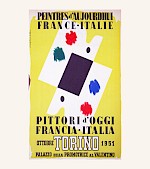The Comunità Artistica, founded in Turin in 1952 by artist Idro Colombi, trained artists specializing in enamel, including Miranda Bestazzi, Marisa Micca, and the future members of Studio Del Campo.
This collective emerged from Colombi’s leadership at the Libera Accademia, an independent art school. Inspired by Olivetti’s innovative work culture, Colombi created a collaborative workshop at Piazza Cavour 14, where he taught grand feu enamel techniques. Olivetti’s industrial environment, enhanced by designs from figures like Ettore Sottsass, provided a fertile space for merging art and design. The Comunità Artistica was also closely tied to designers such as Gio Ponti, reflecting the integration of art and industry.
The 1951 “PITTORI D’OGGI” exhibition, showcasing a dialogue between French and Italian painters, marked a key moment for the group. Works by Picasso, Chagall, and other international artists were displayed alongside Italian painters like Morandi and Guttuso. A significant turning point came when Colombi and his students encountered polychrome enamel works inspired by the monks of Ligugé Abbey, which led them to adopt the grand feu enamel technique.
In the following years, the Comunità Artistica explored various techniques. In 1953, they presented their first works at the International Enamel Exhibition in Geneva, and in 1954, they exhibited in Milan. These years of experimentation solidified their place in the artistic landscape of postwar Turin.
In 1955, the group split, forming Studio Del Campo, whose name and logo were inspired by the “campo” (field) surrounding their original workshop on Via Bellardi. This shift marked the start of a new chapter in their work, focused on the enamel technique that had become their hallmark.

